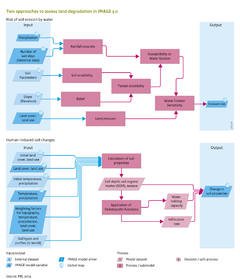Land degradation/Description: Difference between revisions
Jump to navigation
Jump to search
No edit summary |
No edit summary |
||
| Line 77: | Line 77: | ||
* 0.3 for pasture, and | * 0.3 for pasture, and | ||
* 0.0 for natural vegetation. | * 0.0 for natural vegetation. | ||
Land cover is characterised by a remotely sensed {{abbrTemplate|NDVI}} map. The soil property v at location x with soil s is estimated as | Land cover is characterised by a remotely sensed {{abbrTemplate|NDVI}} map. The soil property v at location x with soil s is estimated as {{DisplayFigureLeftOptimalTemplate|Formula1 LD|plain}} with w<sub>x </sub>being a weight w∈ [0..1] that determines where v is in the range [v<sub>ls</sub>..v<sub>hs</sub> ]. Different explanatory factors represented by the landscape properties determine w. The weight at location x is calculated as {{DisplayFigureLeftOptimalTemplate|Formula4 LD|plain}} | ||
{{DisplayFigureLeftOptimalTemplate|Formula1 LD|plain}} | The weight w<sub>px</sub> for landscape property p is calculated as: {{DisplayFigureLeftOptimalTemplate|Formula2 LD|plain}} | ||
with w<sub>x </sub>being a weight w∈ [0..1] that determines where v is in the range [v<sub>ls</sub>..v<sub>hs</sub> ]. Different explanatory factors represented by the landscape properties determine w. The weight at location x is calculated as | |||
{{DisplayFigureLeftOptimalTemplate|Formula4 LD|plain}} | |||
The weight w<sub>px</sub> for landscape property p is calculated as: | |||
{{DisplayFigureLeftOptimalTemplate|Formula2 LD|plain}} | |||
In which c<sub>pv</sub> is a constant that indicates the relative importance of the landscape property p for a soil property v. The sign of c<sub>pv</sub> indicates whether there is a positive or negative relationship between the landscape property and the soil property. | In which c<sub>pv</sub> is a constant that indicates the relative importance of the landscape property p for a soil property v. The sign of c<sub>pv</sub> indicates whether there is a positive or negative relationship between the landscape property and the soil property. | ||
When | When {{DisplayFigureLeftOptimalTemplate|Formula3 LD|plain}} the w∈ [0..1] and all values in the range [v<sub>ls</sub>..v<sub>hs</sub> ] are possible based on the landscape properties. Although in practice c is specific for each landscape property, soil type, and soil property, data are lacking to estimate c at that level of specificity. Therefore the model assumes that c is constant per soil and landscape property, or, in other words, the relative impact of landscape properties on a specific soil property is assumed to be constant over the different soil types. | ||
{{DisplayFigureLeftOptimalTemplate|Formula3 LD|plain}} | |||
the w∈ [0..1] and all values in the range [v<sub>ls</sub>..v<sub>hs</sub> ] are possible based on the landscape properties. Although in practice c is specific for each landscape property, soil type, and soil property, data are lacking to estimate c at that level of specificity. Therefore the model assumes that c is constant per soil and landscape property, or, in other words, the relative impact of landscape properties on a specific soil property is assumed to be constant over the different soil types. | |||
The soil properties are estimated based on land management and land use. This allows for the estimation of soil properties under pristine conditions. For future years, the NDVI map is changed as a function of land use, forest management and assumptions on degradation. To assess pristine conditions, soil properties are calculated with land use set at natural, and land cover represented by the NDVI under pristine conditions. | The soil properties are estimated based on land management and land use. This allows for the estimation of soil properties under pristine conditions. For future years, the NDVI map is changed as a function of land use, forest management and assumptions on degradation. To assess pristine conditions, soil properties are calculated with land use set at natural, and land cover represented by the NDVI under pristine conditions. | ||
Revision as of 12:04, 19 May 2014
Parts of Land degradation/Description
| Component is implemented in: |
|
| Related IMAGE components |
| Projects/Applications |
| Models/Databases |
| Key publications |
| References |
